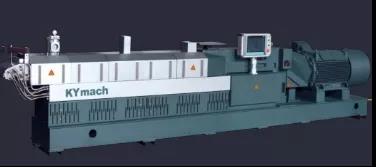Meltblown fabric is the core material of medical masks. After the outbreak of the COVID-19 pandemic, its demand increased, and its price skyrocketed. The price for meltblown fabric, which used to cost 20,000 yuan, has now reached nearly 600,000 yuan. The raw material for meltblown fabric, the PP modified special material, has also risen in price. So how is PP meltblown material produced through meltblown extruder equipment? In this article, Wang Changlong, a senior engineer at Nanjing KY, shares his experience in this regard.
PP meltblown material is mainly used in medical and health, clean materials, thermal insulation and sound insulation cotton, oil-absorbing materials, battery partition, air filtration and daily necessities. The most important protective material, masks, whether N95 or disposable masks, has a main structure consisting of inner and outer spunbond layers (S layer) and a middle meltblown layer (M layer). It is the heart of the mask and its main function is to block and adsorb particles and droplets. The main material of the M layer is PP meltblown material, which has the characteristics of high melt flow rate, low molecular weight, high stability, low odor, and forming a high-strength fiber network structure.
The production process of PP meltblown material is based on PP special resin as the base material, which is generally in powder form with a melt flow index of 30-40. The modified plastic factory uses a meltblown extruder with a dual screw extruder, combined with mature formulas and processes, and adopts polymer controllable rheology technology to process and produce PP meltblown materials.
The PP meltblown specific production equipment, parallel co-rotating dual screw extruder, has developed to the third generation in China. From 2011 to now, KY has developed the third generation of products, which are characterized by high speed and high torque. They can achieve larger output on small machines and are currently the mainstream machines in the market.

The gear box of the third-generation parallel co-rotating dual screw extruder is a high-torque gearbox, which improves the filling degree of materials in the screw, thereby increasing the output of the screw extrusion. It can also reduce the average shear value of materials in the screw during the processing, which is conducive to reducing the yellowing index of the meltblown material and improving its performance index. The groove depth ratio has been unified to 1.55 to ensure reliable amplification effects between different machine types, especially for modified meltblown materials. Small machine production processes can be used for large-scale production equipment, reducing production issues. The surface of the screw elements has been specially treated to improve surface hardness while maintaining good coating toughness, adhesion, and lubricity. This improves the service life and reduces the coefficient of friction, reducing peroxides and PP resin residues to reduce yellowing and black spots, which is beneficial for achieving high quality.
There are three types of cylinder bodies, mainly integrated linings. The more advanced ones are the use of metal sintering technology on the inner surface of the cylinder body. The alloy powder is sintered on the surface of the cylinder body's 8-shaped hole through a special process, forming a layer of uniform and dense alloy layer. This not only solves the defects of the traditional scheme but also improves wear resistance and service life, reduces costs, and reduces corrosion from peroxides, which is essential for material quality. The core shaft is used to string all the key screw components together. High-torque extruder products also require high-torque core shafts, commonly made of four-phosphorus multi-nickel molybdenum. Without changing the core shaft material, the gear design can be optimized to effectively increase the bearing capacity, reduce the pressure angle, reduce the radial force, and reduce the risk of breaks when matching the core shaft and screw components.
The processing of the core parts of the parallel co-rotating dual screw extruder has a significant impact on the quality of the material. The components must be processed on advanced numerical control machining centers to ensure machining accuracy. Then rigorous quality inspections are performed, such as checking the shape and position tolerances of the gearbox in a three-dimensional coordinate measuring machine to ensure 100% qualification before assembly. Then it enters the assembly stage.
During assembly, the coaxiality of the extruder must be ensured. The clearance between the screw and the barrel is generally 0.2mm-0.5mm, ensuring coaxiality, and making sure that the clearance between the screw and the barrel is even and consistent when producing materials. Thus the stability of the melt flow index and molecular weight distribution of PP meltblown material is better. These two important indicators play a crucial role in downstream meltblown fabric production.
The entire production process of PP meltblown material also includes some key auxiliary equipment, such as upstream measuring devices, downstream finished product homogenization devices, and stable control systems, which are beneficial for continuous production stability and batch stability.
 Tel: +86-25-52706155
Tel: +86-25-52706155
 E-mail: info@kymach.com
E-mail: info@kymach.com
 No.59 West Tianyuan Road, Jiangning, Nanjing, Jiangsu Province, China
No.59 West Tianyuan Road, Jiangning, Nanjing, Jiangsu Province, China